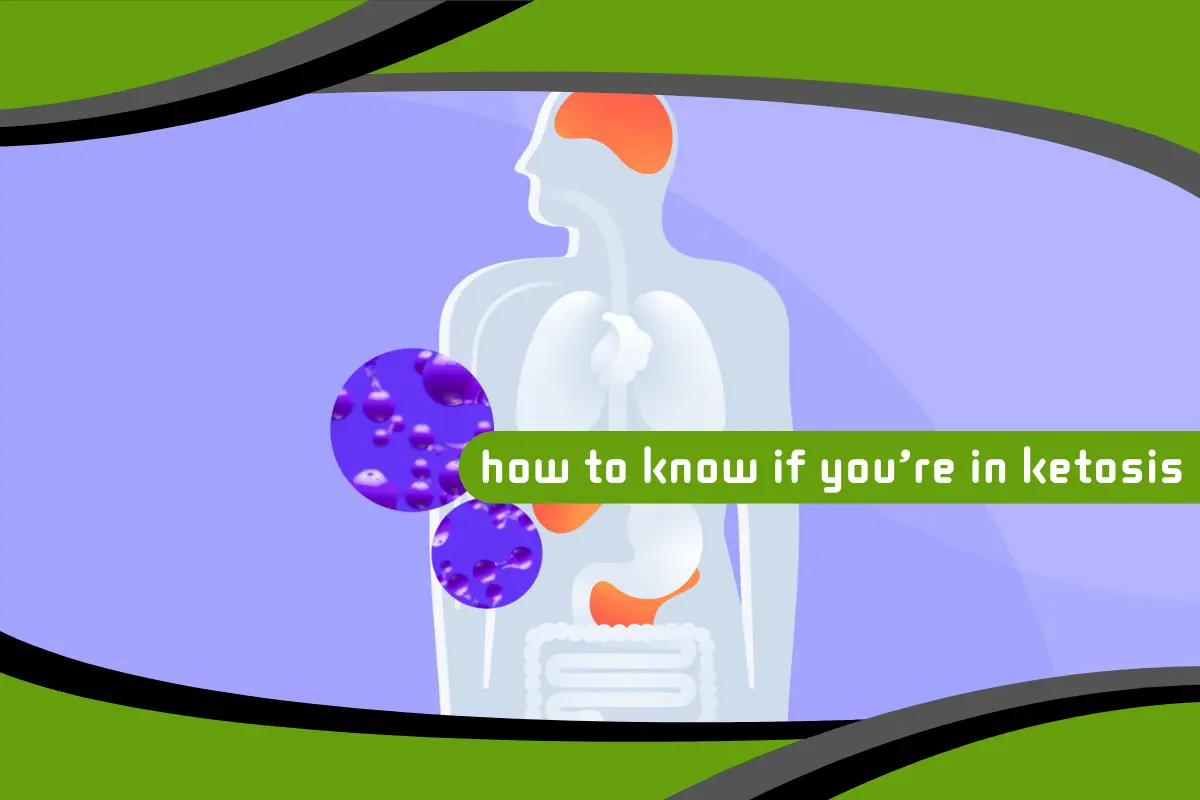The ketogenic diet relies on a dramatic shift in your body’s metabolism—from burning glucose to utilizing fat as the primary source of fuel. This metabolic state is called ketosis, and knowing whether you’ve successfully entered it is essential for anyone following a keto lifestyle. But ketosis isn’t something you can always feel clearly, and guessing isn’t enough when your goals are fat loss, mental clarity, or metabolic health. In this article, we’ll explore how to accurately identify if you’re in ketosis using both subjective signs and objective tools, all from a nutritionist’s professional perspective.

Understanding the Ketosis State
Ketosis occurs when your body produces ketones, which are byproducts of fat metabolism used as an alternative fuel source when carbohydrates are scarce. This process typically begins after a few days of drastically reducing your carbohydrate intake, generally below 50 grams per day. Your liver starts converting fatty acids into ketone bodies, including beta-hydroxybutyrate (BHB), acetoacetate, and acetone. Recognizing this shift is crucial to ensure you’re getting the full benefits of the ketogenic diet.
Why It’s Important to Confirm Ketosis
Confirming whether you’re in ketosis isn’t just about curiosity—it’s about tracking progress, identifying mistakes, and optimizing your health outcomes. Without confirmation, it’s easy to assume you’re in ketosis while unknowingly consuming hidden carbs that knock you out of it. Whether your goals are weight loss, improved cognitive function, or better metabolic markers, knowing your ketone status can guide you toward smarter nutritional choices and better long-term success.
Measuring Blood Ketone Levels
The most accurate way to know if you’re in ketosis is by testing your blood for beta-hydroxybutyrate (BHB). This method uses a blood ketone meter, similar to a glucometer. BHB levels between 0.5 and 3.0 mmol/L generally indicate a state of nutritional ketosis. Though this method involves a small finger prick, it provides the most reliable and consistent results, especially if you are serious about tracking your ketogenic progress.
Watch also: Navigating Occasional Carbs on Keto: A Nutritionist’s Perspective
Using Urine Ketone Strips
Urine ketone strips are a convenient and affordable way to test for the presence of acetoacetate, one of the ketone bodies. These strips change color based on the concentration of ketones in the urine. While less accurate than blood testing, especially after your body becomes keto-adapted, they’re helpful in the early stages of the diet. Keep in mind that hydration levels and time of day can influence results, so use them as a general guideline rather than a precise measurement.
Breath Ketone Analyzers
Another method to assess ketosis is by measuring acetone in your breath using a breath ketone meter. These devices provide a non-invasive alternative to blood or urine testing. While they may not be as precise, breath analyzers offer the advantage of unlimited reuse without ongoing costs. They are particularly helpful for those who dislike blood tests or are looking for daily, real-time feedback.
Reduced Appetite and Cravings
One of the earliest subjective signs of ketosis is a noticeable decrease in hunger and cravings. This occurs because ketones have an appetite-suppressing effect, and stable blood sugar levels reduce the urge to snack or overeat. If you find yourself naturally eating fewer meals or feeling full longer, it could be a good indication that your body is running on ketones rather than glucose.
Increased Mental Clarity and Focus
People in ketosis often report improved cognitive function, enhanced focus, and better mental stamina. Ketones provide a clean-burning, efficient source of fuel for the brain. If you notice that your thoughts are clearer, your mood is more stable, and you’re able to concentrate longer without mental fatigue, these could be subtle but meaningful signs that you’ve entered ketosis.
Boost in Energy and Physical Endurance
Once your body becomes fat-adapted, you may notice a consistent, steady energy level throughout the day without the crashes associated with carb-heavy diets. This increased endurance is especially noticeable during physical activity. Instead of relying on stored glycogen, your body taps into its fat stores for fuel. If workouts feel easier and you recover more quickly, you may be deep in ketosis.
Distinct Breath Odor
A peculiar side effect of ketosis is “keto breath”, often described as fruity, metallic, or similar to nail polish remover. This occurs due to acetone being exhaled as a waste product of fat metabolism. While not everyone experiences this symptom, it’s a commonly reported early sign, especially in the first few weeks of a ketogenic diet.
Short-Term Fatigue or Flu-Like Symptoms
Before your body adapts to ketosis, you might experience symptoms known as the “keto flu”—headaches, fatigue, nausea, and irritability. These symptoms result from electrolyte imbalances and dehydration as your body adjusts to using fat for fuel. While unpleasant, they are often a precursor to entering full ketosis, and managing hydration and electrolytes can ease this transition.
Better Blood Sugar and Insulin Levels
As carbohydrate intake drops and insulin sensitivity improves, you may observe more stable blood sugar levels and reduced insulin spikes. This can be measured using a glucometer or noticed through fewer energy crashes and reduced sugar cravings. These metabolic improvements are often indirect indicators of being in a ketotic state and are beneficial for those with insulin resistance or prediabetes.
Watch also: Keto Ice Cream Recipe (Vanilla & Chocolate): Low-Carb, Sugar-Free & Ultra Creamy
Noticeable Fat Loss
Many people on keto notice rapid fat loss, particularly in the abdominal region, once they enter ketosis. This is partly due to water loss, but also because the body becomes efficient at burning fat for fuel. If your clothes fit differently or your weight drops despite a higher fat intake, it may signal successful ketosis.
Gastrointestinal Changes
Entering ketosis often affects digestion. You may experience constipation, diarrhea, or changes in bowel movement frequency. These shifts are usually temporary and normalize as your digestive system adapts. Paying attention to how your gut responds can offer clues that your metabolism is transitioning into fat-burning mode.
Sleep Pattern Improvements
Many keto followers report deeper, more restful sleep once fully adapted to ketosis. While some experience initial insomnia during the keto transition, long-term ketosis is often associated with improved sleep quality. If you find yourself falling asleep faster and waking up more refreshed, it could be your body responding positively to ketones.
Mood and Emotional Stability
Ketosis is known to stabilize mood, reduce anxiety, and alleviate depressive symptoms in some individuals. The steady energy supply from ketones and the anti-inflammatory effects of a low-carb diet can positively influence neurotransmitter function. Improved emotional regulation and reduced mood swings can indicate that you’re successfully maintaining a ketotic state.
Decreased Bloating and Water Retention
A ketogenic diet significantly reduces bloating and puffiness, especially in the face, abdomen, and extremities. As your insulin levels drop, your kidneys excrete excess water and sodium, leading to a leaner appearance. These changes are often among the first visual confirmations that ketosis is taking effect.
Faster Recovery After Meals
When in ketosis, your post-meal experiences change. You’re less likely to feel sluggish, bloated, or foggy after eating. Meals provide clean, steady energy instead of a carb-induced crash. If you notice improved post-meal alertness and sustained energy, your body is likely thriving in ketosis.
Adaptation Timeline and Patience
Reaching ketosis isn’t instant—it can take several days to a week depending on your carb intake, activity level, and previous diet. The adaptation phase may come with ups and downs, but consistent adherence will eventually lead to ketone production. Patience and daily observation are essential during this early phase.
Combining Signs for a Full Picture
No single sign confirms ketosis with complete certainty. The best approach is to combine multiple indicators—objective tests like blood ketone readings and subjective symptoms like appetite changes or mental clarity. By monitoring both, you get a more accurate and holistic picture of your ketogenic state and how your body is responding.
Watch also: Keto Flu Explained: Causes, Symptoms, and Fast Relief Strategies from a Nutrition Expert



No comment